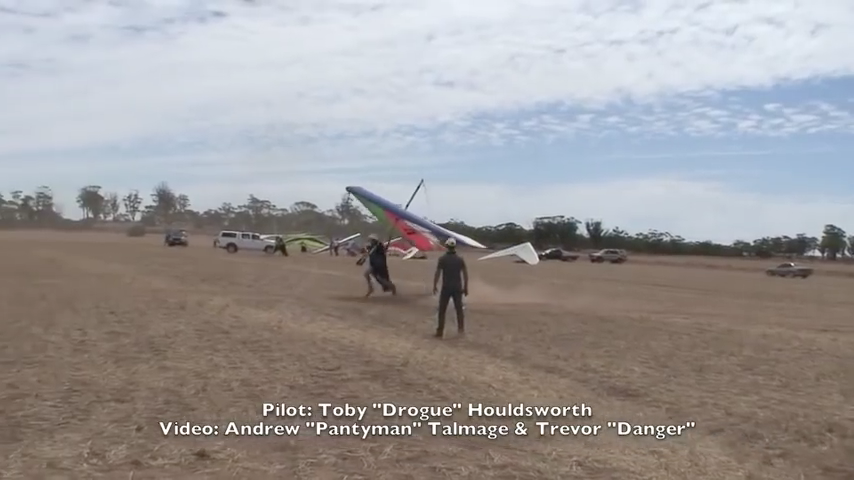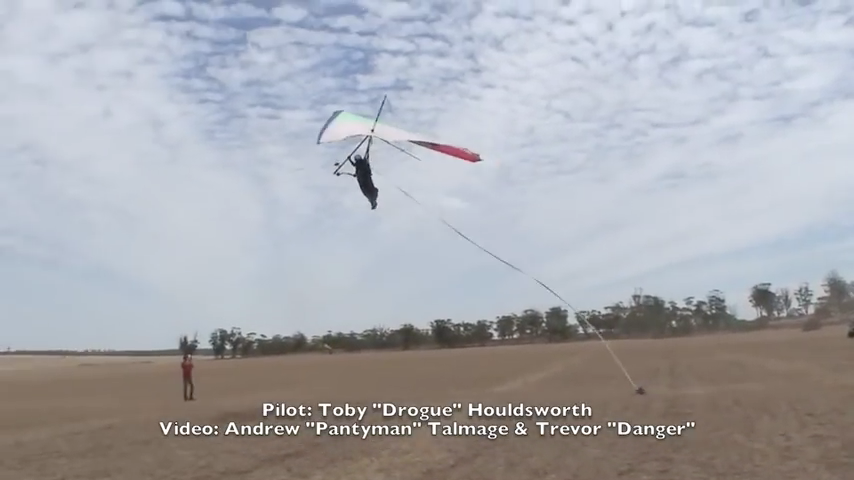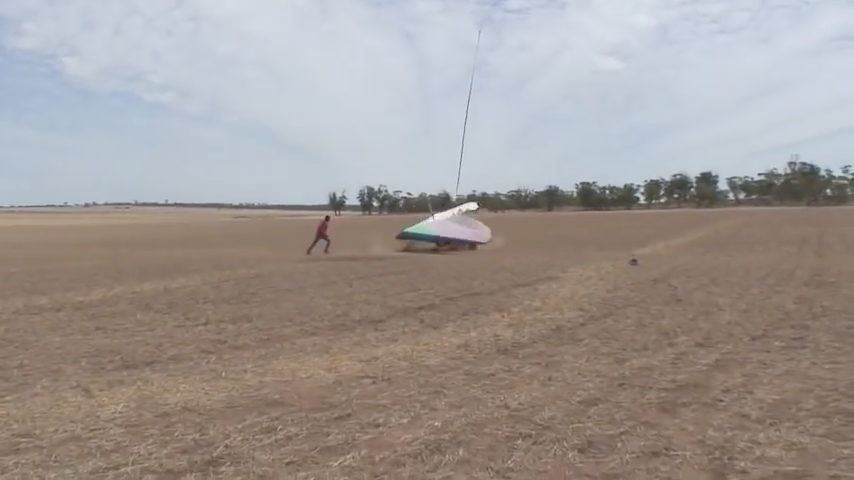Tandem pilot and passenger death
Davis Straub - 2005/10/25 22:16:20 UTC
From: Jules Gilpatrick
To: Davis Straub
Sent: 2005/10/23 16:25
Yep, Davis Dead-On Straub... A name synonymous with greatness. Some people dedicate all their efforts to preventing shit like this, Davis dedicates all his to obstructing and derailing those efforts so's he can do his usual great job of covering them. And great to see you're totally with him on his total contempt for the manslaughter victim's family.Hi Davis,
As usual, great coverage on the accident at Hang Glide Chicago.
Carabineer? Three point? Pro tow?I am curious about your choice of words.
Throw in a towline, pull the glider into a really high pitch attitude and angle of attack, increase the pressure until the two thirds G weak link vaporizes.How does one "increase" a stall?
But why do you ask? You wanna try this on yourself or somebody you don't like much?
How 'bout lockouts? The regular kind you can't recover from or the Wills Wing kind you can - with varying degrees of difficulty depending upon your bridle configuration?In my experience you are either stalled or you are not.
How much control loss is there during those reaches? 100 hundred percent or just 99? Oh, right. You guys can fly those things just fine with ONE hand on the controls.A so-called "partial stall" in my experience has always been a quick realization by the pilot that he has entered a stalled attitude but had reactions quick enough to initiate recovery before the nose fell fully through to its lowest position for the aerodynamic qualities of the glider and its wing and CG loading at the time of the occurrence. We may also be struggling with a semantic problem in this regard as some people consider a "partial" stall to be the same as what others refer to as an "approach" to a stall.
At Vacaville (in the good old days) we used a Blanik L-13 for transition training from a simple 2-33 or 1-26 to a more complicated (read: retractable gear, flaps, brakes and spoilers) type of glider, usually a fiberglass ship. After all the drills (blindfold cockpit, reach for each lever at my call-out)...
How come you don't do them at two HUNDRED feet so the student can fully understand how little there is to fear from stalls?...and some general flying to get used to the handling of the machine, I would have my student drop the gear, pull full flaps and spoilers and do a full stall, (always at 2000' or higher).
Which, if you'd started at 200, would be -600 AGL.The L-13, in that configuration, would REALLY get the student's attention as, at the point of the stall, it would pitch very suddenly full nose down and go vertical. Nothing you could do about it except break the stall with airspeed and then initiate recovery, which included getting rid of the spoilers and raising the flaps. Best altitude loss I was ever able to achieve was about 800 feet by the time I got everything cleaned up.
The Towing Committee was quite aware of thousand foot stalls but was quite content to sit on that information and allow Wallaby to publish in the magazine without challenge that it was impossible to stall an aerotowed glider.Students often lost considerably more than that. After we'd recovered and got back to a normal gliding attitude I would remind the student that he had just flown through a full stall in basic landing configuration for the L-13 and a condition most likely encountered on final when mis-estimation put him low in the glidepath which could cause him to subconsciously be pulling back on the stick to keep the glider flying just a little bit longer in order to make the field. There was no way ANYBODY could recover from that condition on final because there simply was not enough room between them and the ground to do so, i.e. there was no such thing as a "partial" stall for the L-13 in that configuration.
My point is that I think a harder look has to be taken at the actual stall characteristics of all gliders used for tandem flying.
http://www.hanggliding.org/viewtopic.php?t=14230It could well be that there is indeed an insurmountable "Interval of Death" for all tandem flights taken on tow during which time there is no way ANYBODY can recover from a stall in time to just fly away, even from 1000' AGL due to the basic aerodynamics of the glider design, carrying the load it was designed for.
pro tow set-up
Ryan Voight - 2009/11/03 05:24:31 UTC
It works best in a lockout situation... if you're banked away from the tug and have the bar back by your belly button... let it out. Glider will pitch up, break weaklink, and you fly away.
http://www.hanggliding.org/viewtopic.php?t=14230I may get ration of poop...
pro tow set-up
Jim Rooney - 2009/11/03 06:16:56 UTC
As for being in a situation where you can't or don't want to let go, Ryan's got the right idea. They're called "weak" links for a reason. Overload that puppy and you bet your ass it's going to break.
You can tell me till you're blue in the face about situations where it theoretically won't let go or you can drone on and on about how "weaklinks only protect the glider" (which is BS btw)... and I can tell ya... I could give a crap, cuz just pitch out abruptly and that little piece of string doesn't have a chance in hell. Take your theory and shove it... I'm saving my a$$.
And those with really keen intellects....from more knowledgeable persons...
Bullshit. If you were just trying to learn like everybody else you wouldn't be talking about stalls as if they were lethally dangerous. Everybody else understands that they're mere inconveniences....for this idea but I am just trying to learn like everybody else.
Good start. This stuff is so simple that damn near anybody safely above Rooney/Voight/Fink level can easily understand it and anybody who DOES claim to be and/or identifies another as a "more knowledgeable person"...Sergey Kataev - 2005/10/26 00:12:57 UTC
To Jules Gilpatrick
I can't claim to be a "more knowledgeable person"...
http://www.hanggliding.org/viewtopic.php?t=17404
Aerotow barrel release - straight or curved pin?
http://ozreport.com/forum/viewtopic.php?t=24846Jim Rooney - 2010/05/31 01:53:13 UTC
BTW, Steve Wendt is exceptionally knowledgeable. Hell, he's the one that signed off my instructor rating.
Is this a joke ?
http://www.ushawks.org/forum/viewtopic.php?f=23&t=811Jim Rooney - 2011/08/25 04:55:25 UTC
Ditto dude.
It always amazes to hear know it all pilots arguing with the professional pilots.
I mean seriously, this is our job.
We do more tows in a day than they do in a month (year for most).
We *might* have an idea of how this stuff works.
They *might* do well to listen.
FTHI
...is totally full of shit.Bob Kuczewski - 2011/10/25 07:28:43 UTC
Joe Greblo knows far more about hang gliding than I probably ever will. If you can convince him that he should be teaching "lift and tug" instead of "turn and check", then you'll get my vote of support.
Told ya you get much better information from people who don't claim to be more knowledgeable persons....but it seems to me that a hangglider has a little more washout than a sailplane. It must cause the root of wing to stall first while wing tips are still flying. Then you can "increase" the stall by pushing the bar out even further and holding it there. This makes hanggliders more forgiving in their stall than sailplanes.
Didn't you read the accounts? They weren't desperately trying to catch the tug in climb. They were just low on the tug. To say what you are would imply that the tug was doing a shit job of the tow. And if that were the case...Regarding the accident, a link breaking when a pilot is desperately trying to catch the tug in climb...
http://www.chgpa.org/forums/viewtopic.php?f=2&t=3600
Weak link question
http://ozreport.com/forum/viewtopic.php?t=30971Jim Rooney - 2008/11/24 05:18:15 UTC
Well, I'm assuming there was some guff about the tug pilot's right of refusal?
Gee, didn't think we'd have to delve into "pilot in command"... I figured that one's pretty well understood in a flying community.
It's quite simple.
The tug is a certified aircraft... the glider is an unpowered ultralight vehicle. The tug pilot is the pilot in command. You are a passenger. You have the same rights and responsibilities as a skydiver.
It's a bitter pill I'm sure, but there you have it.
BTW, if you think I'm just spouting theory here, I've personally refused to tow a flight park owner over this very issue. I didn't want to clash, but I wasn't towing him. Yup, he wanted to tow with a doubled up weaklink. He eventually towed (behind me) with a single and sorry to disappoint any drama mongers, we're still friends. And lone gun crazy Rooney? Ten other tow pilots turned him down that day for the same reason.
Zach Marzec
...the Pilot In Command of that flight would be deader than a doornail and his passengers would be smelling like roses - not the other way around.Jim Rooney - 2013/02/16 05:05:41 UTC
Here's a little bit of bitter reality that ya'll get to understand straight off. I won't be sugar coating it, sorry.
You see, I'm on the other end of that rope.
I want neither a dead pilot on my hands or one trying to kill me.
And yes. It is my call. PERIOD.
On tow, I am the PIC.
Now, that cuts hard against every fiber of every HG pilot on the planet and I get that.
Absolutely no HG pilot likes hearing it. Not me, not no one. BUT... sorry, that's the way it is.
Accept it and move on.
Not only can you not change it, it's the law... in the very literal sense.
Bullshit. An enhanced inconvenience - at worst....seems like a reasonable scenario for a mentioned "superstall"...
http://ozreport.com/forum/viewtopic.php?t=31052...when the nose is much higher than in a normal stall, and the gravity slows the glider down even more, wing tips produce no lift (read: pitch down force is weak), and the whole thing falls a lot longer before it rotates the nose down.
Poll on weaklinks
Jim Rooney - 2013/03/05 21:40:02 UTC
I'm not saying that you've claimed that a stronger weaklink allows for a greater AOA... I'm telling you that it does.
You know this.
I'll spell it out anyway...
Increases in AOA increase the load factor... push it beyond what the weaklink can stand and *POP*, you're off tow.
Increase the load factor that the weaklink can withstand and you increase the achievable AOA.
This ain't truck towing. There is no pressure limiting mechanism. Push out and you load the line. Push out hard and you'll break the weaklink... that's the whole idea.
You want to break off the towline? Push out... push out hard... it will break.
As others have pointed out, they've used this fact intentionally to get off tow. It works.
You want MORE.
I want you to have less.
This is the fundamental disagreement.
You're afraid of breaking off with a high AOA? Good... tow with a WEAKER weaklink... you won't be able to achieve a high AOA. Problem solved.
I'm sorry that you don't like that the tug pilot has the last word... but tough titties.
Don't like it?
Don't ask me to tow you.
Go troll somewhere else buddy.
I'm over this.



